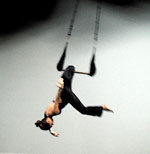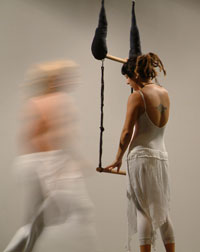



O-T-O mobilizes multiple trapezes
The "Intimate Spaces" of O-T-O' upcoming dance concert "are also precarious perches," the company's Artistic Director Anne Bunker says impishly. Some of the program's six pieces explore the relationships we have with space, from balancing within the endless grip of gravity to being haunted by delicate, drifting memories of ancient landscapes. Other pieces focus on relationships between bodies, from the pull of past selves in dreams to the sometimes all-too-solid presence of husbands and wives. The concert unveils an adventure in aerial art, as the O-T-O Dance literally goes mobile. After seven years of dancing through the air by means of the low-flying trapeze, Bunker recently began casting around for new challenges. Her husband, composer Chuck Koesters, intrigued her with the idea of complicating the single trapeze by suspending several together to make huge mobiles. The company unveils its experiment in the premiere of "Balanced Edge," a set of duets pairing Bunker with Nicole Buffan and Charles Thompson with Matthew Henley. The piece, says Bunker, is one part of a full-length work to be presented next season. In most dance, the hardest part of the art is transforming a series of distinct, often difficult moves into a seamless, apparently effortless whole. In aerial dance, the fragile fracture points are the transitions from floor up to trapeze and down again, as well as the shifts between different kinds of suspension from the trapeze. In mobile dancing, these feats of balance and control become almost superhumanly complex. Instead of working with a single bar that sways and spins from a still point, the dancers will use two trapezes hung from the ends of a longer bar. The individual trapezes still spin and sway, but the points from which they are suspended will also be moving up, down and around - "like a revolving seesaw, or the horses of a carousel," says Bunker. What's most crucial, she repO-T-O, laughing like a kid with a new toy, is absolute trust in your mobile partner. "If you're not paying attention, one of you is going to end up - thud - with your rear on the floor, while the other person's suddenly dangling way high up, from a vertical pole," Bunker explains. "Same as when someone jumps on the end of a teeter-totter." The rest of the concert gathers an array of more traditional though still exciting modern dances. "Sky Islands," an aerial work that premiered last summer, revels in the exhilaration and dizzying exposure of perching on mountain peaks. The remaining dances leave the heights to move along the plane of the ground. Flor de Liz Alzate, one of Tucson's finest young dancers, premieres her piece, "Strings Attached," about a dreamed encounter with a past self who appears as a marionette. Katherine Harts' short piece, "HAIKU 1," dances out the contrasts within music by John Cage. Jan Justice's wickedly gleeful work about married life - ". . . Do us Part . . ." - injects some satirical laughter into the program. Finally, Bunker, Alzate and Mimi Chen dance through mysterious ruins in the Scottish Highlands as the company returns its multimedia piece, "Speaking Places," to the stage. |
||||